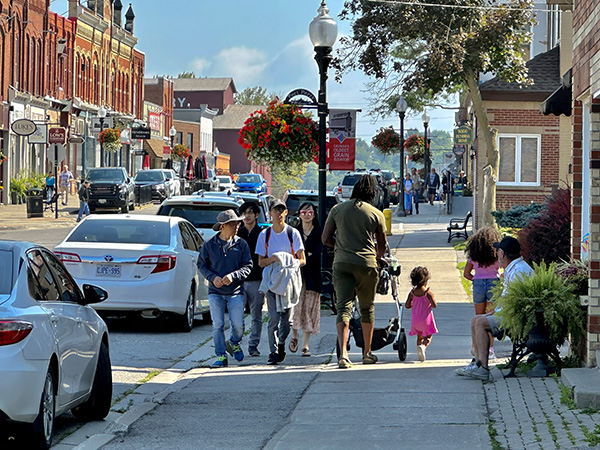
With the exponential growth of technology occurring today, there is an often-repeated adage that “the law struggles to keep up with technology.” As such, it is always interesting when the highest Wisconsin court must spend its limited time with the bleeding edge issue…. what is a sidewalk? The recent Wisconsin Supreme Court decision, Sojenhomer LLC v. Village of Egg Harbor, shows that the Court still must decide, and for the first time, a very early 20th century issue.
Anyone who has spent time in Door County during the summer can attest to the incredible busyness of its towns lined with shops, wine tastings and restaurants. The heavy traffic, combined with parked vehicles and pedestrians on two lane highways can lead to tight and dangerous corridors. In 2015, after hearing numerous complaints about the dangerousness of downtown Egg Harbor for pedestrians, specifically the area of the intersection of County Highway G and State Highway 42, the Village of Egg Harbor decided to act. The Village decided to add a new sidewalk on the on the east side of the County Highway G, among other changes. To build the sidewalk, the Village needed to acquire, through its condemnation power, the 0.009 acres that belonged to Sojenhomer LLC; on that property, Sojenhomer operated the Shipwrecked Brew Pub and Restaurant and used that .009 acres for parking.
Sojenhomer sued to stop the Village on the grounds that the condemnation was prohibited by Wis. Stat. § 32.015, which bars the use of condemnation powers to establish “a pedestrian way.” In Sojenhomer’s eyes, obviously a sidewalk is a pedestrian way, so the Village could not condemn its property to build its desired sidewalk. Unsurprisingly, the Village took the opposite view: “a pedestrian way” and a “sidewalk” were distinct and separate things. Illustrating how unsettled the matter was, the local circuit court agreed with the Village; the Wisconsin Court of Appeals agreed with Sojenhomer.
As the decider of last resort, the Wisconsin Supreme Court agreed with the Village: the legislature’s definition of “pedestrian way” does not include “sidewalk.” Appropriate for the exciting nature of dried concrete, the Court relied on good old-fashioned statutory interpretation rules to reach its decision. The Court found that the statute used the terms “sidewalk” and “pedestrian way” in ways that each term had separate, non-overlapping meaning. To the Court, the fact that various statutes used both terms indicates that the terms were not one in the same. Moreover, when the legislature first introduced the term “pedestrian way,a way designated for pedestrian travel” – in 1949, the statutes already contained a definition of “sidewalk” as “that portion of a highway between the curb lines and adjacent property lines.” In other words, if a pedestrian way was a sidewalk or a sidewalk was a pedestrian way, there would be no reason for both terms to exist.
The Court noted that sidewalks are a ubiquitous feature of road projects across the state, and if the legislature wanted to prohibit the use of condemnation to build sidewalks, they could have done so easily and clearly. Instead, when limiting condemnation powers, the legislature did not include the word “sidewalk” and instead included the seldom-used phrase “pedestrian way.”
If any dedicated reader has made it this far, he or she hopefully recognizes the slightly tongue-in-cheek nature of this issue. Yet, this case serves as an important reminder and illustration that our courts continue to grapple vigorously (this was a 4-3 decision) with issues and words that most residents would consider antiquated. The ever-changing nature of our world, and its attendant needs, highlight how the stale terms and law must be constantly applied to new fact scenarios every day.
